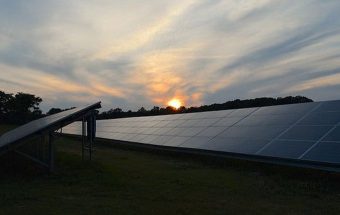
An enormous solar power plant has been proposed for Cleve Hill in Kent on the east coast of England. The 350 megawatt facility would cover 900 acres of farmland and salt marshes near Faversham, known to Charles Dickens fans as the home of Pip in the novel Great Expectations. When completed in 2020, the project would be 5 times larger than any other solar power plant in the UK and would make enough electricity for 110,000 area homes. It would connect to the utility grid through the same substation utilized by the London Array offshore wind farm located nearby.
The size of the project has everything to do with a decision by the UK government to end subsidies for solar power 18 months ago. Since then, smaller systems have become uneconomical. Only larger installations are able to compete on price with other forms of energy.
The developers are Hive Energy of the UK and Wirsol Energy of Germany. “The Cleve Hill solar park is a pioneering scheme that aims to optimize the technological developments in solar energy,” says Hugh Brennan of Hive Energy. “Our ambition is to deliver the first non-subsidized renewables project of this scale, delivering low-cost, clean, homegrown energy to power UK households.”
Not everyone is thrilled with the proposal, as evidenced by this headline from the Daily Mail — “Giant solar farm’s threat to glorious Kent coastline: Site the size of 500 football pitches will cost £400m and power 110,000 homes.” Salt marshes are, of course, vital to the environment and often are home to migratory birds, including marsh harriers, lapwing, reed warblers, grey plovers, and black-tailed godwit.
Hilary Newport, director of the Campaign to Protect Rural England, tells the BBC, “If I was to think of the worst possible place to put a solar farm, it would be here. We absolutely support the principle of renewable energy, but [the panels] should be on roofs, not trashing landscapes in an astonishingly beautiful part of the Kent marshes,” she says in a perfect example of how NIMBY sentiments impact renewable energy considerations. In point of fact, Ms. Newport, rooftop solar has been neutered by the UK’s decision to end tax incentives for solar energy.
Speaking for 10:10, one of the UK’s leading climate advocacy groups, Max Wakefield says. “It’s a real ray of sunshine to see such ambitious clean energy projects emerging in the UK despite the policy obstacles. But the scale this project has had to adopt in order to be commercially viable is also a warning.” A spokesperson for the Solar Trade Association amplifies on that warning. “Government policy of excluding solar from clean power auctions is driving larger projects in a bid to get the economics to work.”
There will be much public discussion about how to build the new solar power plant so it satisfies the concerns of all interested parties. “We are still at the very early stages of developing our proposals, which is why we want to start talking now with local communities to understand their views and listen to their ideas,” says Hugh Brennan of Hive Energy. “I would encourage anyone with an interest in our plans to come along to meet us at one of our upcoming consultation events to find out more.”
The size of the proposed Cleve Hill facility is dictated by economic concerns, which in turn are dictated by government policies. The larger the project, the more likely it is to have negative impacts on the surrounding environment. It will be interesting to see how Hive Energy and Wirsol Energy resolve those issues and what impediments national and local governments put in their path. Forging a low carbon future often involves making hard choices.
Source: cleantechnica.com



